Systematic Review on Hand Hygiene and Nosocomial Infection Prevention
VerifiedAdded on 2022/09/12
|20
|4673
|21
Literature Review
AI Summary
This paper presents a systematic review of literature focusing on the importance of hand hygiene in infection control and the reduction of nosocomial infections. It addresses the prevalence and risks associated with hospital-acquired infections, emphasizing hand hygiene as a practical solution. The review employs a structured search strategy across medical databases like BioMed Central, PubMed Central, CINAHL, and Cochrane Database of Systematic Reviews, utilizing keywords and Boolean operators to identify relevant peer-reviewed articles published between 2011 and 2020. Inclusion and exclusion criteria were applied to filter studies based on publication type, language, and methodological rigor, prioritizing systematic reviews, randomized control trials, and prospective cohort studies. The methodological quality of the selected studies was assessed using CASP checklists to ensure validity and reliability. The review synthesizes findings from ten studies, examining the effectiveness of hand washing techniques versus alcohol-based sanitizers, the impact of hand hygiene education, and strategies for improving hand hygiene compliance in healthcare settings. The review highlights the importance of multimodal interventions and adherence to clinical practice guidelines to reduce the incidence of nosocomial infections, including Clostridium difficile infections.
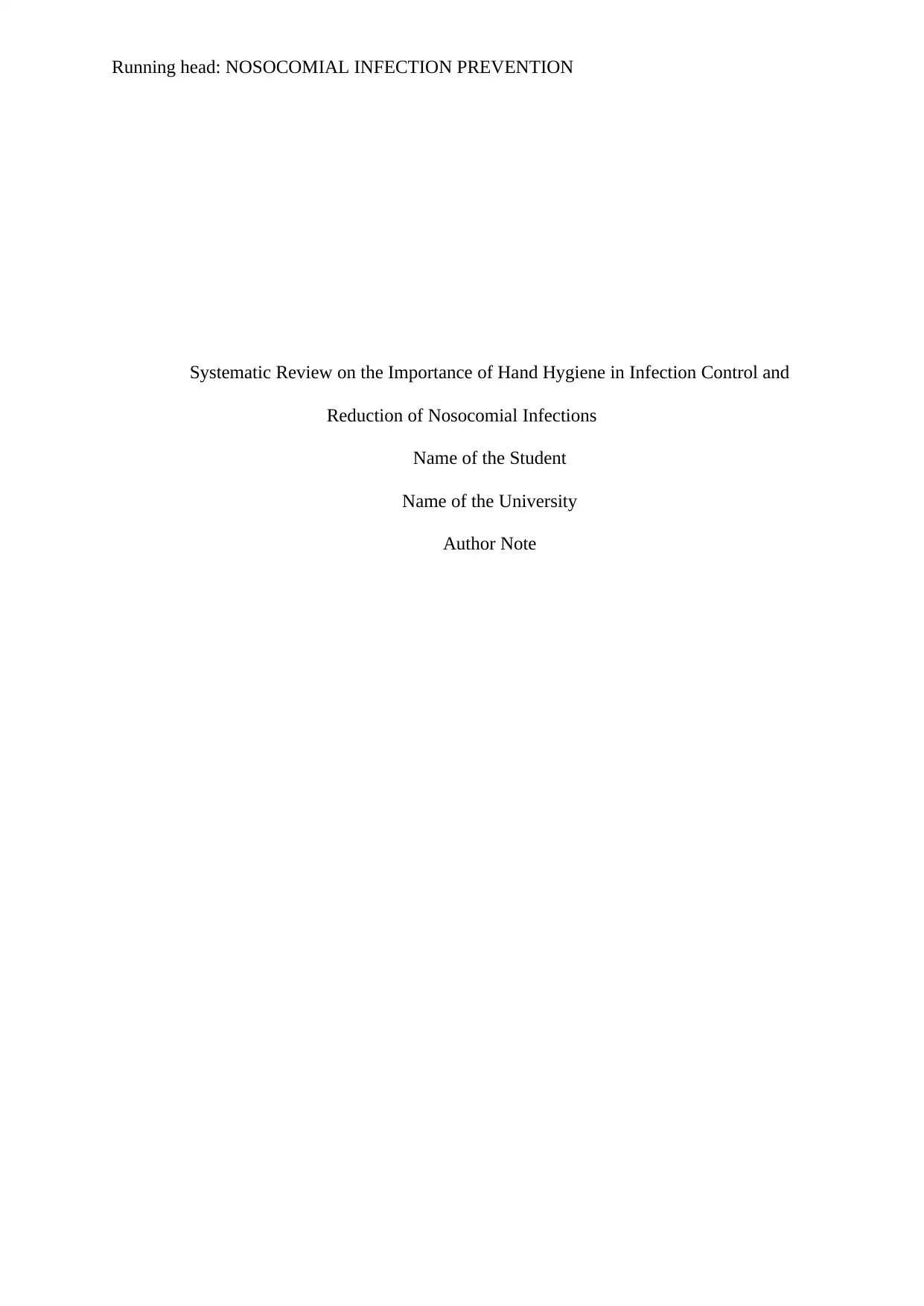
Running head: NOSOCOMIAL INFECTION PREVENTION
Systematic Review on the Importance of Hand Hygiene in Infection Control and
Reduction of Nosocomial Infections
Name of the Student
Name of the University
Author Note
Systematic Review on the Importance of Hand Hygiene in Infection Control and
Reduction of Nosocomial Infections
Name of the Student
Name of the University
Author Note
Paraphrase This Document
Need a fresh take? Get an instant paraphrase of this document with our AI Paraphraser
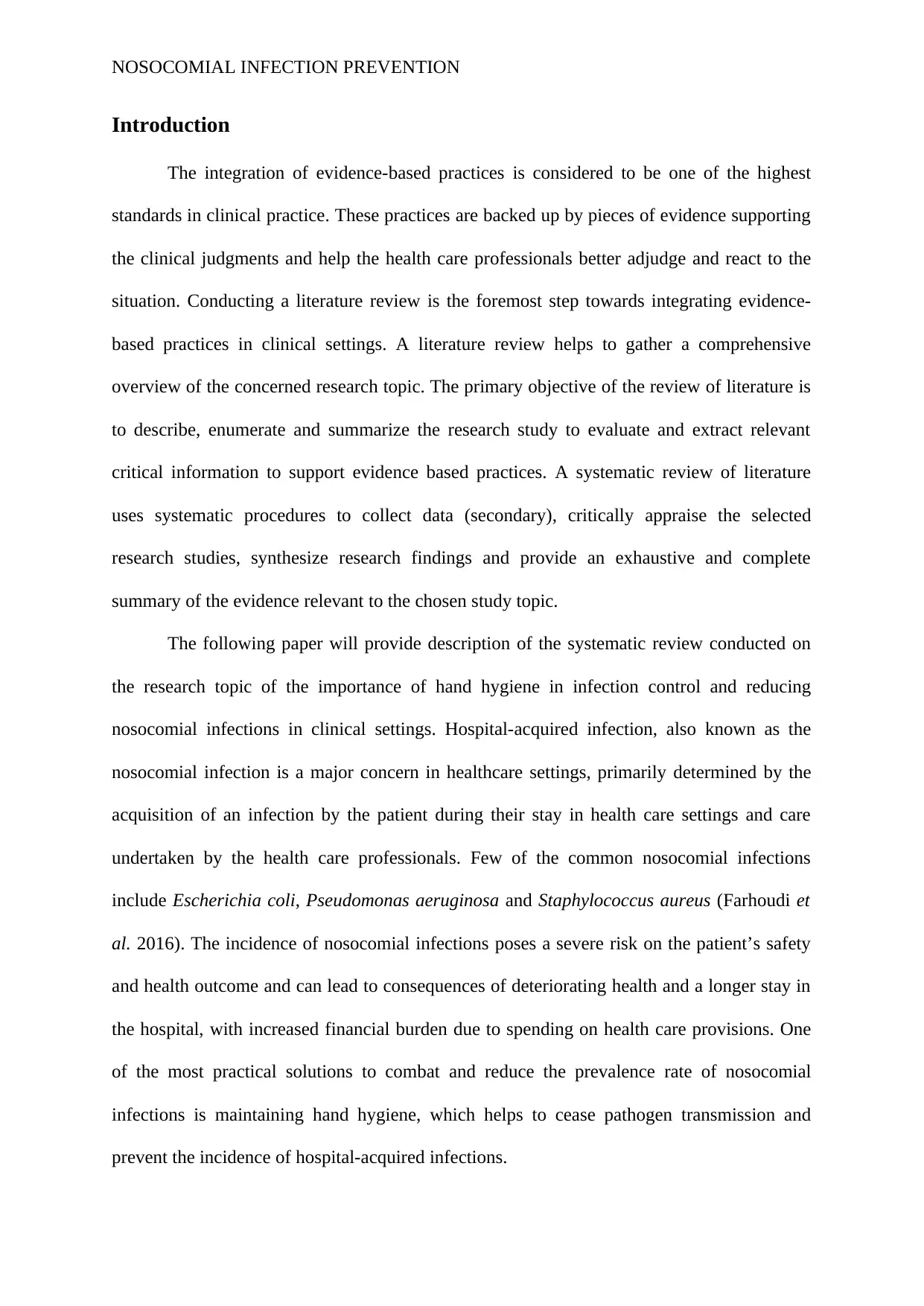
NOSOCOMIAL INFECTION PREVENTION
Introduction
The integration of evidence-based practices is considered to be one of the highest
standards in clinical practice. These practices are backed up by pieces of evidence supporting
the clinical judgments and help the health care professionals better adjudge and react to the
situation. Conducting a literature review is the foremost step towards integrating evidence-
based practices in clinical settings. A literature review helps to gather a comprehensive
overview of the concerned research topic. The primary objective of the review of literature is
to describe, enumerate and summarize the research study to evaluate and extract relevant
critical information to support evidence based practices. A systematic review of literature
uses systematic procedures to collect data (secondary), critically appraise the selected
research studies, synthesize research findings and provide an exhaustive and complete
summary of the evidence relevant to the chosen study topic.
The following paper will provide description of the systematic review conducted on
the research topic of the importance of hand hygiene in infection control and reducing
nosocomial infections in clinical settings. Hospital-acquired infection, also known as the
nosocomial infection is a major concern in healthcare settings, primarily determined by the
acquisition of an infection by the patient during their stay in health care settings and care
undertaken by the health care professionals. Few of the common nosocomial infections
include Escherichia coli, Pseudomonas aeruginosa and Staphylococcus aureus (Farhoudi et
al. 2016). The incidence of nosocomial infections poses a severe risk on the patient’s safety
and health outcome and can lead to consequences of deteriorating health and a longer stay in
the hospital, with increased financial burden due to spending on health care provisions. One
of the most practical solutions to combat and reduce the prevalence rate of nosocomial
infections is maintaining hand hygiene, which helps to cease pathogen transmission and
prevent the incidence of hospital-acquired infections.
Introduction
The integration of evidence-based practices is considered to be one of the highest
standards in clinical practice. These practices are backed up by pieces of evidence supporting
the clinical judgments and help the health care professionals better adjudge and react to the
situation. Conducting a literature review is the foremost step towards integrating evidence-
based practices in clinical settings. A literature review helps to gather a comprehensive
overview of the concerned research topic. The primary objective of the review of literature is
to describe, enumerate and summarize the research study to evaluate and extract relevant
critical information to support evidence based practices. A systematic review of literature
uses systematic procedures to collect data (secondary), critically appraise the selected
research studies, synthesize research findings and provide an exhaustive and complete
summary of the evidence relevant to the chosen study topic.
The following paper will provide description of the systematic review conducted on
the research topic of the importance of hand hygiene in infection control and reducing
nosocomial infections in clinical settings. Hospital-acquired infection, also known as the
nosocomial infection is a major concern in healthcare settings, primarily determined by the
acquisition of an infection by the patient during their stay in health care settings and care
undertaken by the health care professionals. Few of the common nosocomial infections
include Escherichia coli, Pseudomonas aeruginosa and Staphylococcus aureus (Farhoudi et
al. 2016). The incidence of nosocomial infections poses a severe risk on the patient’s safety
and health outcome and can lead to consequences of deteriorating health and a longer stay in
the hospital, with increased financial burden due to spending on health care provisions. One
of the most practical solutions to combat and reduce the prevalence rate of nosocomial
infections is maintaining hand hygiene, which helps to cease pathogen transmission and
prevent the incidence of hospital-acquired infections.
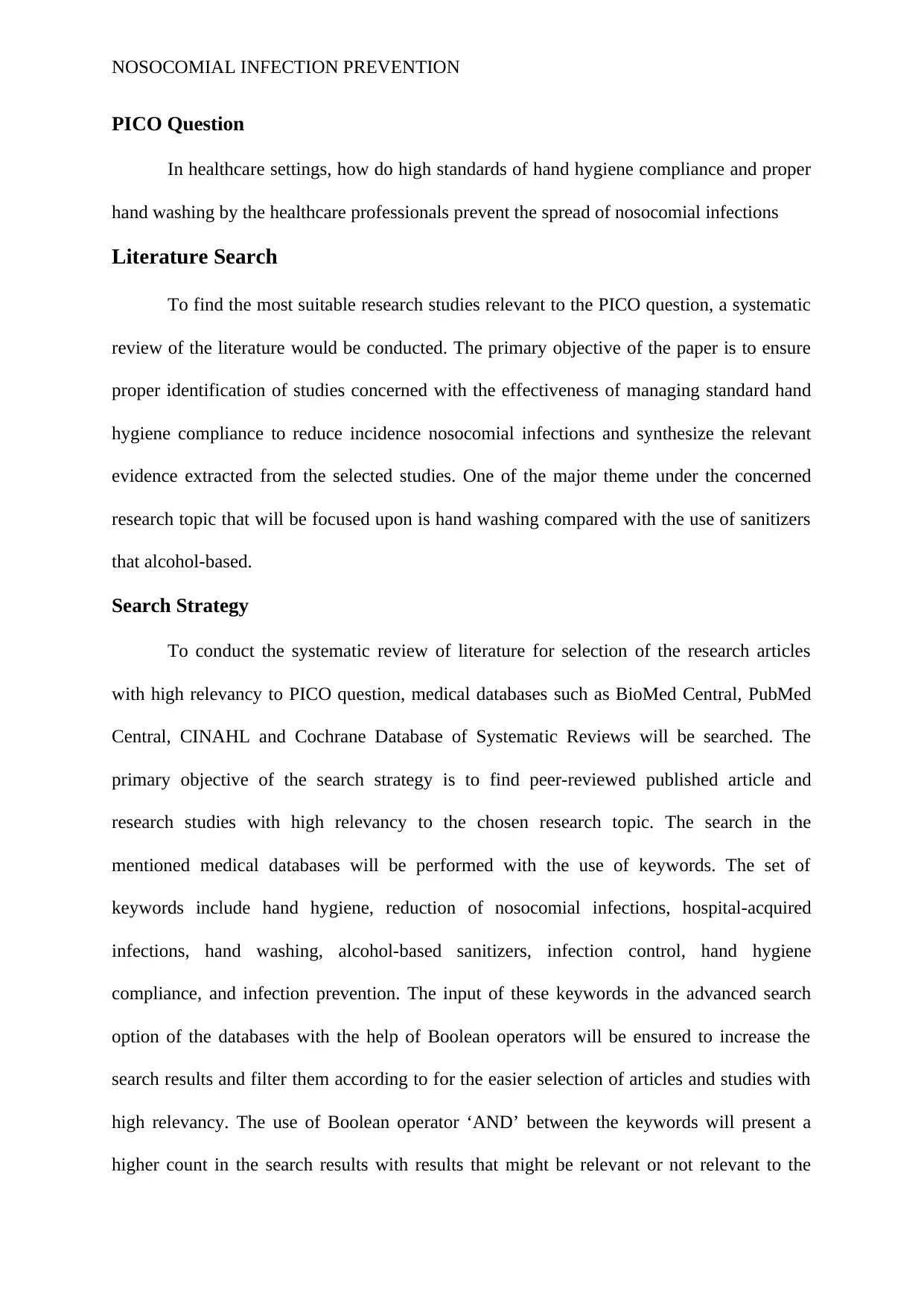
NOSOCOMIAL INFECTION PREVENTION
PICO Question
In healthcare settings, how do high standards of hand hygiene compliance and proper
hand washing by the healthcare professionals prevent the spread of nosocomial infections
Literature Search
To find the most suitable research studies relevant to the PICO question, a systematic
review of the literature would be conducted. The primary objective of the paper is to ensure
proper identification of studies concerned with the effectiveness of managing standard hand
hygiene compliance to reduce incidence nosocomial infections and synthesize the relevant
evidence extracted from the selected studies. One of the major theme under the concerned
research topic that will be focused upon is hand washing compared with the use of sanitizers
that alcohol-based.
Search Strategy
To conduct the systematic review of literature for selection of the research articles
with high relevancy to PICO question, medical databases such as BioMed Central, PubMed
Central, CINAHL and Cochrane Database of Systematic Reviews will be searched. The
primary objective of the search strategy is to find peer-reviewed published article and
research studies with high relevancy to the chosen research topic. The search in the
mentioned medical databases will be performed with the use of keywords. The set of
keywords include hand hygiene, reduction of nosocomial infections, hospital-acquired
infections, hand washing, alcohol-based sanitizers, infection control, hand hygiene
compliance, and infection prevention. The input of these keywords in the advanced search
option of the databases with the help of Boolean operators will be ensured to increase the
search results and filter them according to for the easier selection of articles and studies with
high relevancy. The use of Boolean operator ‘AND’ between the keywords will present a
higher count in the search results with results that might be relevant or not relevant to the
PICO Question
In healthcare settings, how do high standards of hand hygiene compliance and proper
hand washing by the healthcare professionals prevent the spread of nosocomial infections
Literature Search
To find the most suitable research studies relevant to the PICO question, a systematic
review of the literature would be conducted. The primary objective of the paper is to ensure
proper identification of studies concerned with the effectiveness of managing standard hand
hygiene compliance to reduce incidence nosocomial infections and synthesize the relevant
evidence extracted from the selected studies. One of the major theme under the concerned
research topic that will be focused upon is hand washing compared with the use of sanitizers
that alcohol-based.
Search Strategy
To conduct the systematic review of literature for selection of the research articles
with high relevancy to PICO question, medical databases such as BioMed Central, PubMed
Central, CINAHL and Cochrane Database of Systematic Reviews will be searched. The
primary objective of the search strategy is to find peer-reviewed published article and
research studies with high relevancy to the chosen research topic. The search in the
mentioned medical databases will be performed with the use of keywords. The set of
keywords include hand hygiene, reduction of nosocomial infections, hospital-acquired
infections, hand washing, alcohol-based sanitizers, infection control, hand hygiene
compliance, and infection prevention. The input of these keywords in the advanced search
option of the databases with the help of Boolean operators will be ensured to increase the
search results and filter them according to for the easier selection of articles and studies with
high relevancy. The use of Boolean operator ‘AND’ between the keywords will present a
higher count in the search results with results that might be relevant or not relevant to the
⊘ This is a preview!⊘
Do you want full access?
Subscribe today to unlock all pages.

Trusted by 1+ million students worldwide
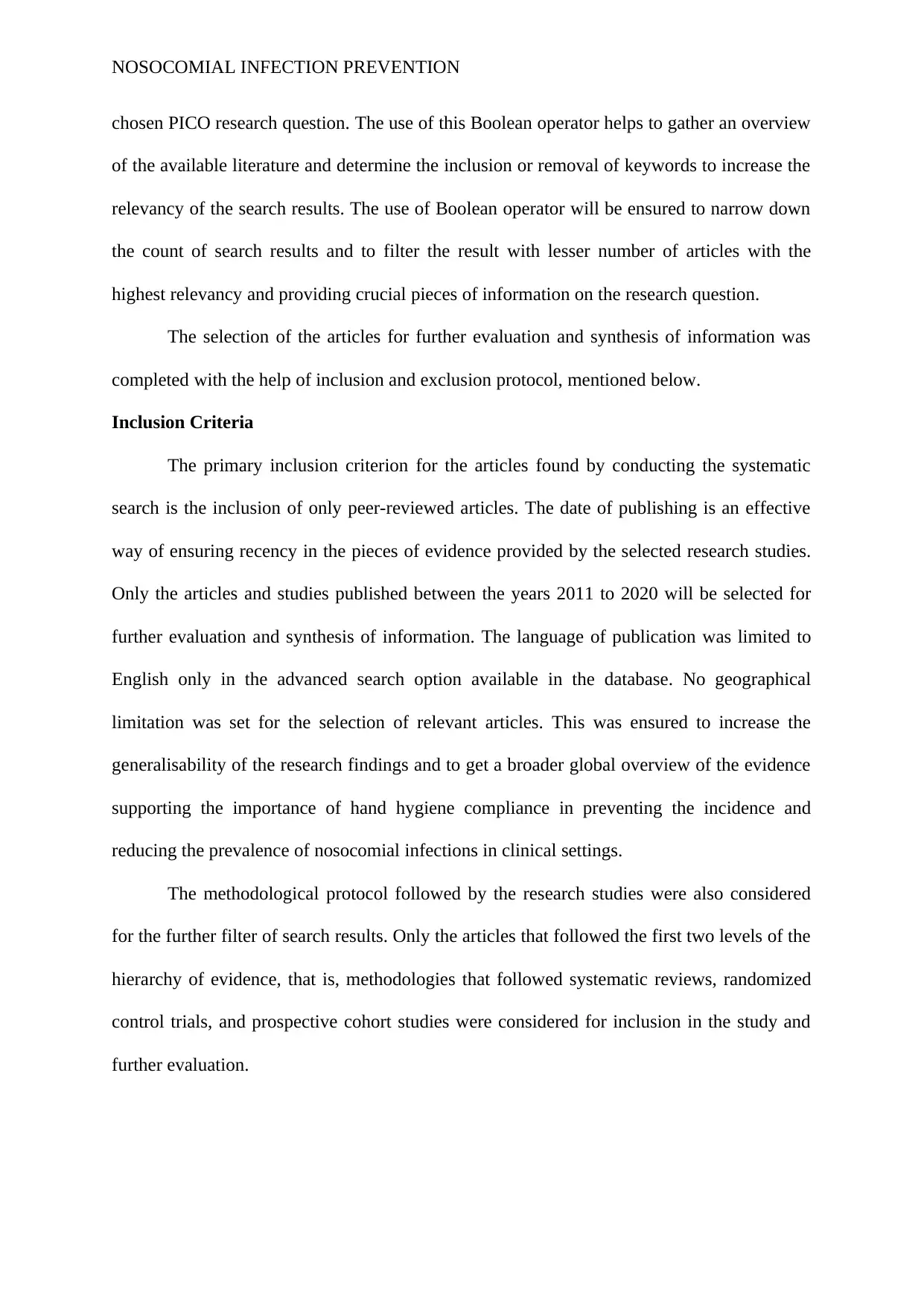
NOSOCOMIAL INFECTION PREVENTION
chosen PICO research question. The use of this Boolean operator helps to gather an overview
of the available literature and determine the inclusion or removal of keywords to increase the
relevancy of the search results. The use of Boolean operator will be ensured to narrow down
the count of search results and to filter the result with lesser number of articles with the
highest relevancy and providing crucial pieces of information on the research question.
The selection of the articles for further evaluation and synthesis of information was
completed with the help of inclusion and exclusion protocol, mentioned below.
Inclusion Criteria
The primary inclusion criterion for the articles found by conducting the systematic
search is the inclusion of only peer-reviewed articles. The date of publishing is an effective
way of ensuring recency in the pieces of evidence provided by the selected research studies.
Only the articles and studies published between the years 2011 to 2020 will be selected for
further evaluation and synthesis of information. The language of publication was limited to
English only in the advanced search option available in the database. No geographical
limitation was set for the selection of relevant articles. This was ensured to increase the
generalisability of the research findings and to get a broader global overview of the evidence
supporting the importance of hand hygiene compliance in preventing the incidence and
reducing the prevalence of nosocomial infections in clinical settings.
The methodological protocol followed by the research studies were also considered
for the further filter of search results. Only the articles that followed the first two levels of the
hierarchy of evidence, that is, methodologies that followed systematic reviews, randomized
control trials, and prospective cohort studies were considered for inclusion in the study and
further evaluation.
chosen PICO research question. The use of this Boolean operator helps to gather an overview
of the available literature and determine the inclusion or removal of keywords to increase the
relevancy of the search results. The use of Boolean operator will be ensured to narrow down
the count of search results and to filter the result with lesser number of articles with the
highest relevancy and providing crucial pieces of information on the research question.
The selection of the articles for further evaluation and synthesis of information was
completed with the help of inclusion and exclusion protocol, mentioned below.
Inclusion Criteria
The primary inclusion criterion for the articles found by conducting the systematic
search is the inclusion of only peer-reviewed articles. The date of publishing is an effective
way of ensuring recency in the pieces of evidence provided by the selected research studies.
Only the articles and studies published between the years 2011 to 2020 will be selected for
further evaluation and synthesis of information. The language of publication was limited to
English only in the advanced search option available in the database. No geographical
limitation was set for the selection of relevant articles. This was ensured to increase the
generalisability of the research findings and to get a broader global overview of the evidence
supporting the importance of hand hygiene compliance in preventing the incidence and
reducing the prevalence of nosocomial infections in clinical settings.
The methodological protocol followed by the research studies were also considered
for the further filter of search results. Only the articles that followed the first two levels of the
hierarchy of evidence, that is, methodologies that followed systematic reviews, randomized
control trials, and prospective cohort studies were considered for inclusion in the study and
further evaluation.
Paraphrase This Document
Need a fresh take? Get an instant paraphrase of this document with our AI Paraphraser
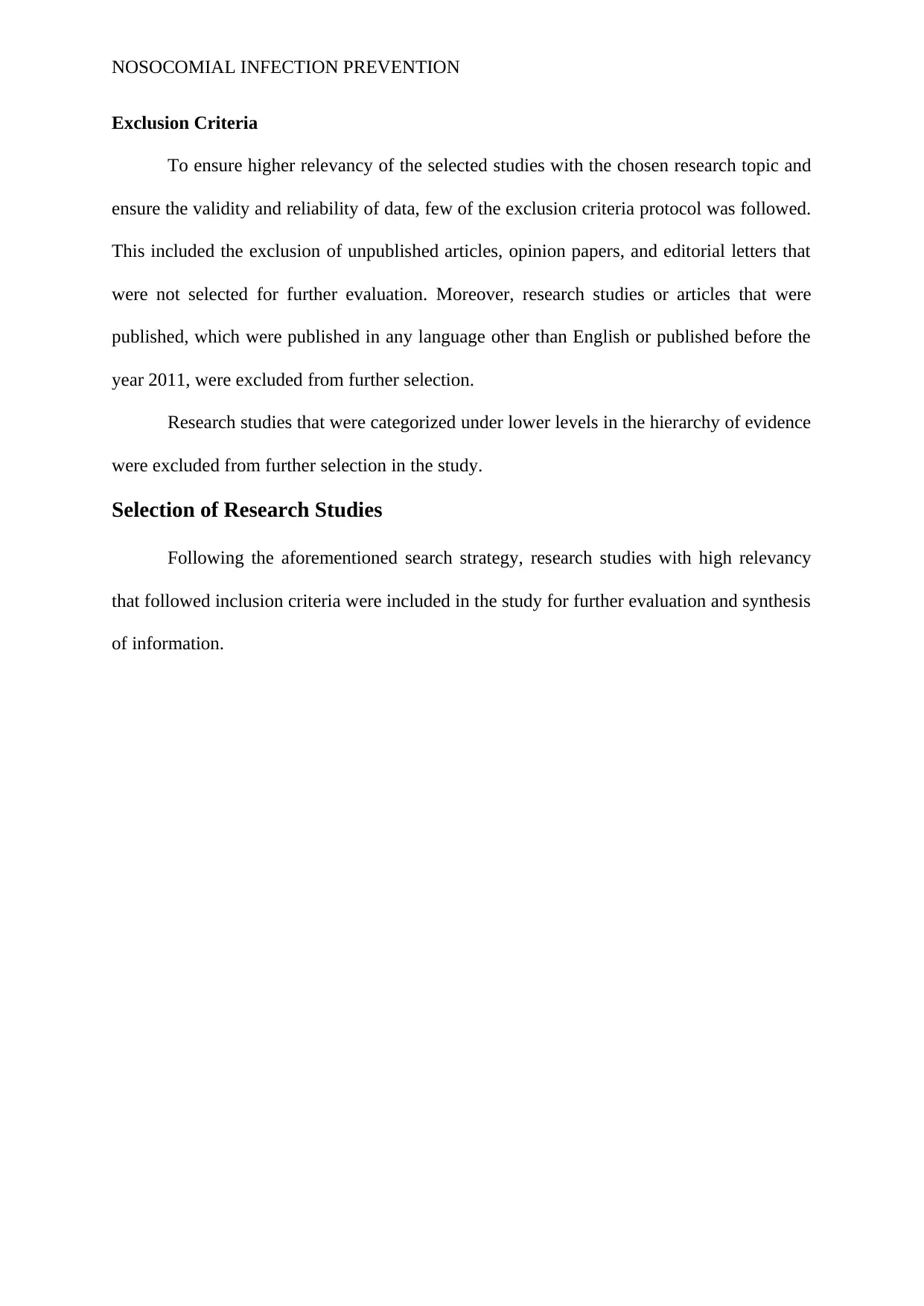
NOSOCOMIAL INFECTION PREVENTION
Exclusion Criteria
To ensure higher relevancy of the selected studies with the chosen research topic and
ensure the validity and reliability of data, few of the exclusion criteria protocol was followed.
This included the exclusion of unpublished articles, opinion papers, and editorial letters that
were not selected for further evaluation. Moreover, research studies or articles that were
published, which were published in any language other than English or published before the
year 2011, were excluded from further selection.
Research studies that were categorized under lower levels in the hierarchy of evidence
were excluded from further selection in the study.
Selection of Research Studies
Following the aforementioned search strategy, research studies with high relevancy
that followed inclusion criteria were included in the study for further evaluation and synthesis
of information.
Exclusion Criteria
To ensure higher relevancy of the selected studies with the chosen research topic and
ensure the validity and reliability of data, few of the exclusion criteria protocol was followed.
This included the exclusion of unpublished articles, opinion papers, and editorial letters that
were not selected for further evaluation. Moreover, research studies or articles that were
published, which were published in any language other than English or published before the
year 2011, were excluded from further selection.
Research studies that were categorized under lower levels in the hierarchy of evidence
were excluded from further selection in the study.
Selection of Research Studies
Following the aforementioned search strategy, research studies with high relevancy
that followed inclusion criteria were included in the study for further evaluation and synthesis
of information.
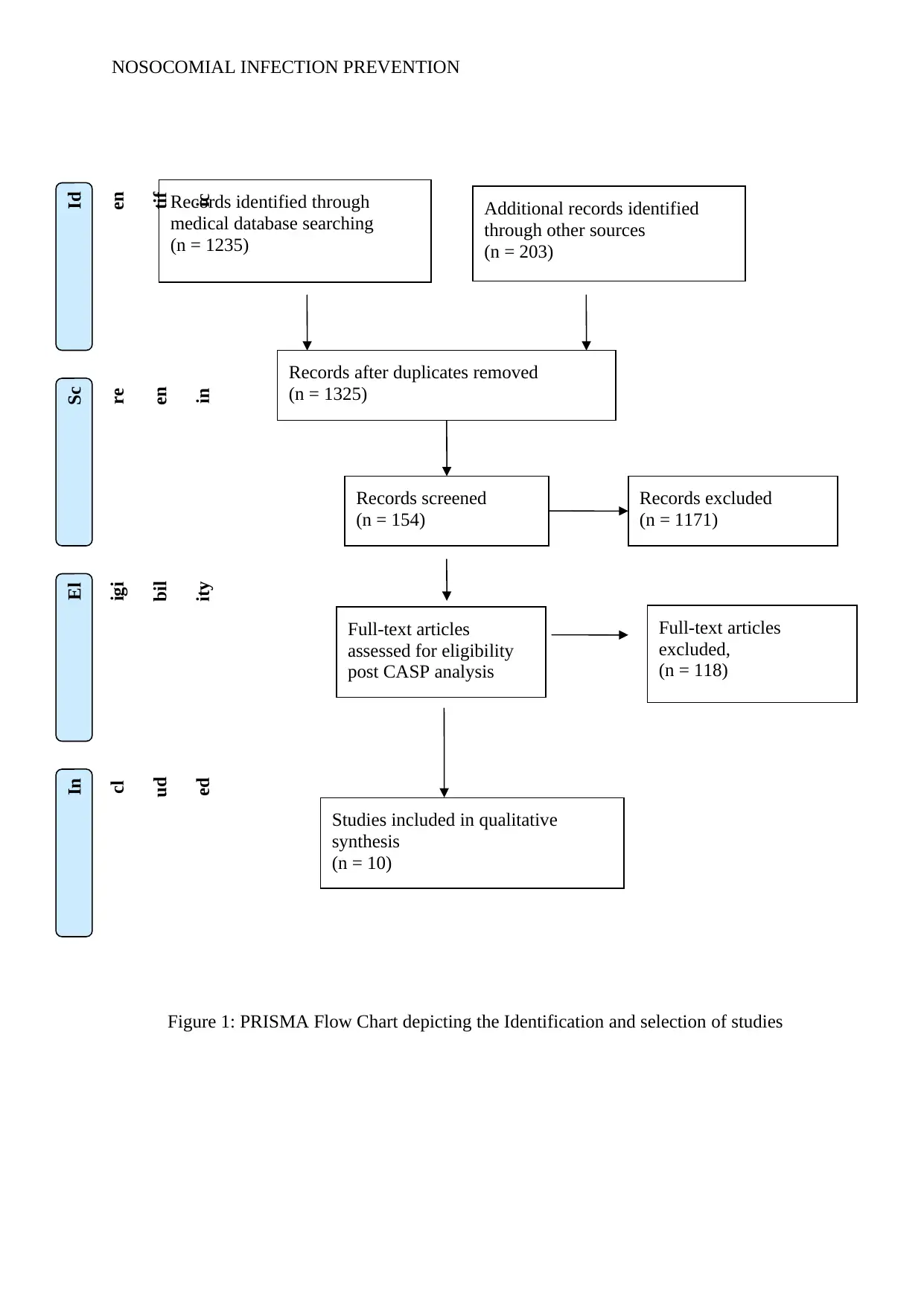
NOSOCOMIAL INFECTION PREVENTION
Figure 1: PRISMA Flow Chart depicting the Identification and selection of studies
Records identified through
medical database searching
(n = 1235)
Sc
re
en
in
g
In
cl
ud
ed
El
igi
bil
ity
Id
en
tif
ic
ati
Additional records identified
through other sources
(n = 203)
Records after duplicates removed
(n = 1325)
Records screened
(n = 154)
Records excluded
(n = 1171)
Full-text articles
assessed for eligibility
post CASP analysis
(n = 36)
Full-text articles
excluded,
(n = 118)
Studies included in qualitative
synthesis
(n = 10)
Figure 1: PRISMA Flow Chart depicting the Identification and selection of studies
Records identified through
medical database searching
(n = 1235)
Sc
re
en
in
g
In
cl
ud
ed
El
igi
bil
ity
Id
en
tif
ic
ati
Additional records identified
through other sources
(n = 203)
Records after duplicates removed
(n = 1325)
Records screened
(n = 154)
Records excluded
(n = 1171)
Full-text articles
assessed for eligibility
post CASP analysis
(n = 36)
Full-text articles
excluded,
(n = 118)
Studies included in qualitative
synthesis
(n = 10)
⊘ This is a preview!⊘
Do you want full access?
Subscribe today to unlock all pages.

Trusted by 1+ million students worldwide
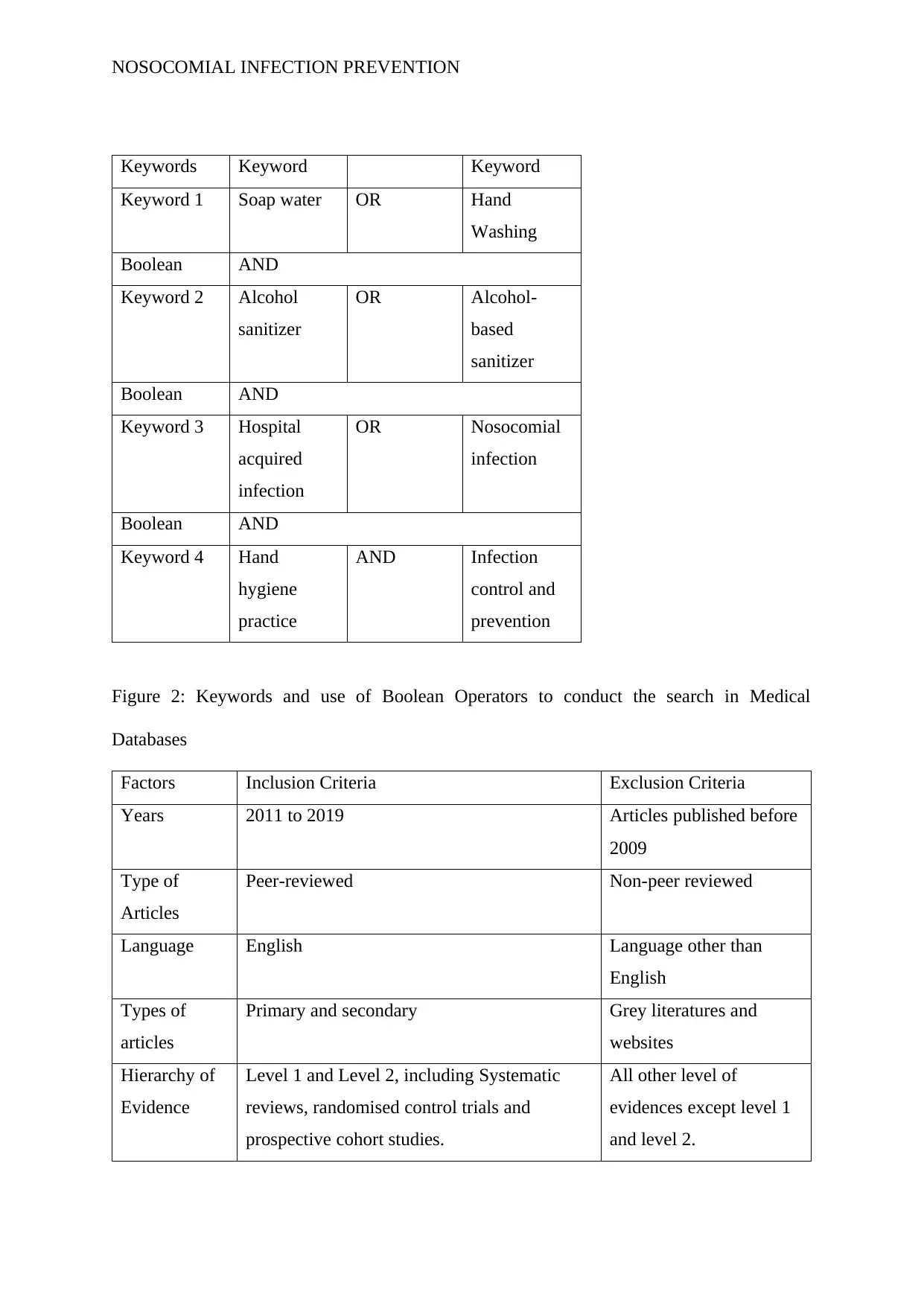
NOSOCOMIAL INFECTION PREVENTION
Keywords Keyword Keyword
Keyword 1 Soap water OR Hand
Washing
Boolean AND
Keyword 2 Alcohol
sanitizer
OR Alcohol-
based
sanitizer
Boolean AND
Keyword 3 Hospital
acquired
infection
OR Nosocomial
infection
Boolean AND
Keyword 4 Hand
hygiene
practice
AND Infection
control and
prevention
Figure 2: Keywords and use of Boolean Operators to conduct the search in Medical
Databases
Factors Inclusion Criteria Exclusion Criteria
Years 2011 to 2019 Articles published before
2009
Type of
Articles
Peer-reviewed Non-peer reviewed
Language English Language other than
English
Types of
articles
Primary and secondary Grey literatures and
websites
Hierarchy of
Evidence
Level 1 and Level 2, including Systematic
reviews, randomised control trials and
prospective cohort studies.
All other level of
evidences except level 1
and level 2.
Keywords Keyword Keyword
Keyword 1 Soap water OR Hand
Washing
Boolean AND
Keyword 2 Alcohol
sanitizer
OR Alcohol-
based
sanitizer
Boolean AND
Keyword 3 Hospital
acquired
infection
OR Nosocomial
infection
Boolean AND
Keyword 4 Hand
hygiene
practice
AND Infection
control and
prevention
Figure 2: Keywords and use of Boolean Operators to conduct the search in Medical
Databases
Factors Inclusion Criteria Exclusion Criteria
Years 2011 to 2019 Articles published before
2009
Type of
Articles
Peer-reviewed Non-peer reviewed
Language English Language other than
English
Types of
articles
Primary and secondary Grey literatures and
websites
Hierarchy of
Evidence
Level 1 and Level 2, including Systematic
reviews, randomised control trials and
prospective cohort studies.
All other level of
evidences except level 1
and level 2.
Paraphrase This Document
Need a fresh take? Get an instant paraphrase of this document with our AI Paraphraser
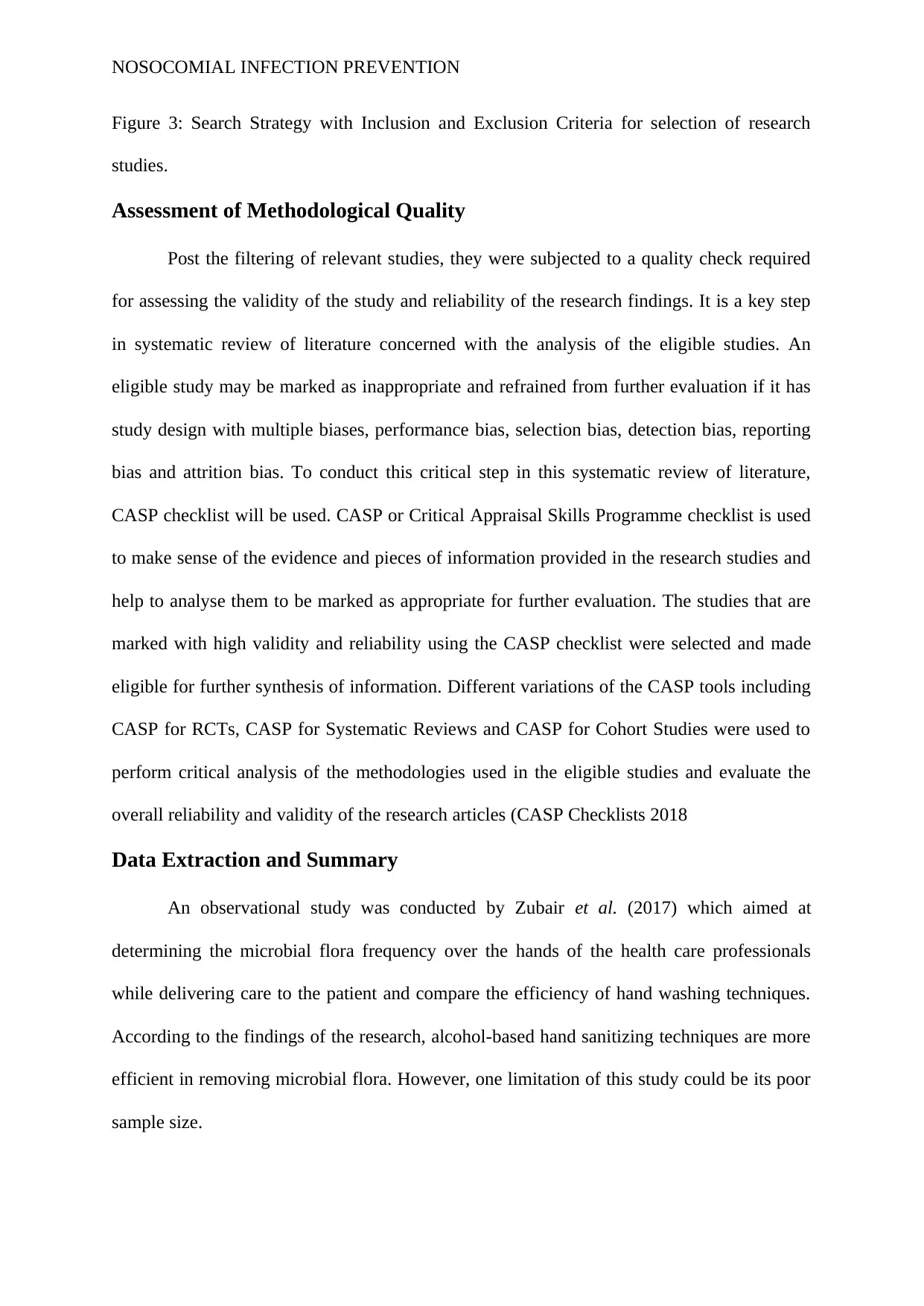
NOSOCOMIAL INFECTION PREVENTION
Figure 3: Search Strategy with Inclusion and Exclusion Criteria for selection of research
studies.
Assessment of Methodological Quality
Post the filtering of relevant studies, they were subjected to a quality check required
for assessing the validity of the study and reliability of the research findings. It is a key step
in systematic review of literature concerned with the analysis of the eligible studies. An
eligible study may be marked as inappropriate and refrained from further evaluation if it has
study design with multiple biases, performance bias, selection bias, detection bias, reporting
bias and attrition bias. To conduct this critical step in this systematic review of literature,
CASP checklist will be used. CASP or Critical Appraisal Skills Programme checklist is used
to make sense of the evidence and pieces of information provided in the research studies and
help to analyse them to be marked as appropriate for further evaluation. The studies that are
marked with high validity and reliability using the CASP checklist were selected and made
eligible for further synthesis of information. Different variations of the CASP tools including
CASP for RCTs, CASP for Systematic Reviews and CASP for Cohort Studies were used to
perform critical analysis of the methodologies used in the eligible studies and evaluate the
overall reliability and validity of the research articles (CASP Checklists 2018
Data Extraction and Summary
An observational study was conducted by Zubair et al. (2017) which aimed at
determining the microbial flora frequency over the hands of the health care professionals
while delivering care to the patient and compare the efficiency of hand washing techniques.
According to the findings of the research, alcohol-based hand sanitizing techniques are more
efficient in removing microbial flora. However, one limitation of this study could be its poor
sample size.
Figure 3: Search Strategy with Inclusion and Exclusion Criteria for selection of research
studies.
Assessment of Methodological Quality
Post the filtering of relevant studies, they were subjected to a quality check required
for assessing the validity of the study and reliability of the research findings. It is a key step
in systematic review of literature concerned with the analysis of the eligible studies. An
eligible study may be marked as inappropriate and refrained from further evaluation if it has
study design with multiple biases, performance bias, selection bias, detection bias, reporting
bias and attrition bias. To conduct this critical step in this systematic review of literature,
CASP checklist will be used. CASP or Critical Appraisal Skills Programme checklist is used
to make sense of the evidence and pieces of information provided in the research studies and
help to analyse them to be marked as appropriate for further evaluation. The studies that are
marked with high validity and reliability using the CASP checklist were selected and made
eligible for further synthesis of information. Different variations of the CASP tools including
CASP for RCTs, CASP for Systematic Reviews and CASP for Cohort Studies were used to
perform critical analysis of the methodologies used in the eligible studies and evaluate the
overall reliability and validity of the research articles (CASP Checklists 2018
Data Extraction and Summary
An observational study was conducted by Zubair et al. (2017) which aimed at
determining the microbial flora frequency over the hands of the health care professionals
while delivering care to the patient and compare the efficiency of hand washing techniques.
According to the findings of the research, alcohol-based hand sanitizing techniques are more
efficient in removing microbial flora. However, one limitation of this study could be its poor
sample size.
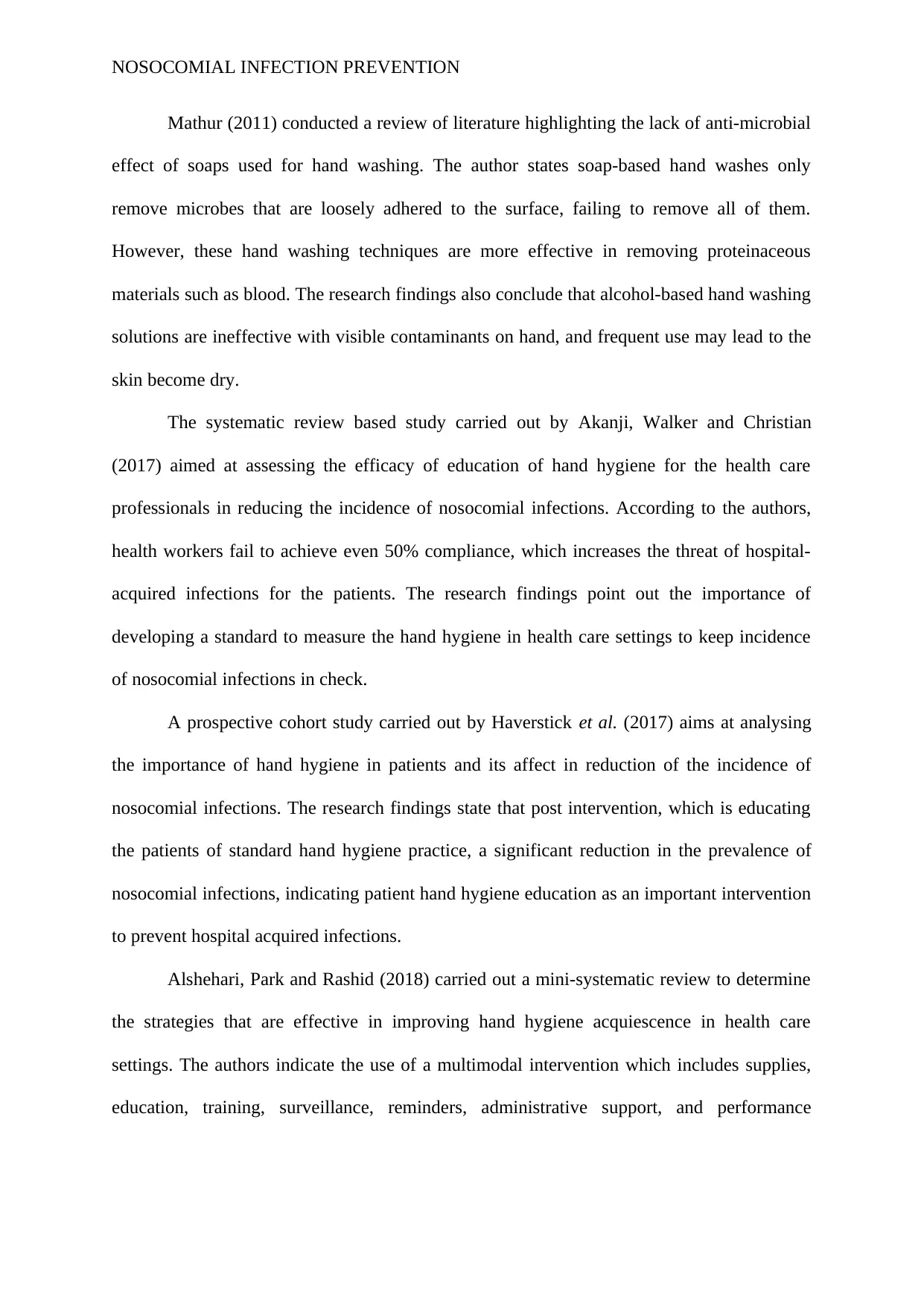
NOSOCOMIAL INFECTION PREVENTION
Mathur (2011) conducted a review of literature highlighting the lack of anti-microbial
effect of soaps used for hand washing. The author states soap-based hand washes only
remove microbes that are loosely adhered to the surface, failing to remove all of them.
However, these hand washing techniques are more effective in removing proteinaceous
materials such as blood. The research findings also conclude that alcohol-based hand washing
solutions are ineffective with visible contaminants on hand, and frequent use may lead to the
skin become dry.
The systematic review based study carried out by Akanji, Walker and Christian
(2017) aimed at assessing the efficacy of education of hand hygiene for the health care
professionals in reducing the incidence of nosocomial infections. According to the authors,
health workers fail to achieve even 50% compliance, which increases the threat of hospital-
acquired infections for the patients. The research findings point out the importance of
developing a standard to measure the hand hygiene in health care settings to keep incidence
of nosocomial infections in check.
A prospective cohort study carried out by Haverstick et al. (2017) aims at analysing
the importance of hand hygiene in patients and its affect in reduction of the incidence of
nosocomial infections. The research findings state that post intervention, which is educating
the patients of standard hand hygiene practice, a significant reduction in the prevalence of
nosocomial infections, indicating patient hand hygiene education as an important intervention
to prevent hospital acquired infections.
Alshehari, Park and Rashid (2018) carried out a mini-systematic review to determine
the strategies that are effective in improving hand hygiene acquiescence in health care
settings. The authors indicate the use of a multimodal intervention which includes supplies,
education, training, surveillance, reminders, administrative support, and performance
Mathur (2011) conducted a review of literature highlighting the lack of anti-microbial
effect of soaps used for hand washing. The author states soap-based hand washes only
remove microbes that are loosely adhered to the surface, failing to remove all of them.
However, these hand washing techniques are more effective in removing proteinaceous
materials such as blood. The research findings also conclude that alcohol-based hand washing
solutions are ineffective with visible contaminants on hand, and frequent use may lead to the
skin become dry.
The systematic review based study carried out by Akanji, Walker and Christian
(2017) aimed at assessing the efficacy of education of hand hygiene for the health care
professionals in reducing the incidence of nosocomial infections. According to the authors,
health workers fail to achieve even 50% compliance, which increases the threat of hospital-
acquired infections for the patients. The research findings point out the importance of
developing a standard to measure the hand hygiene in health care settings to keep incidence
of nosocomial infections in check.
A prospective cohort study carried out by Haverstick et al. (2017) aims at analysing
the importance of hand hygiene in patients and its affect in reduction of the incidence of
nosocomial infections. The research findings state that post intervention, which is educating
the patients of standard hand hygiene practice, a significant reduction in the prevalence of
nosocomial infections, indicating patient hand hygiene education as an important intervention
to prevent hospital acquired infections.
Alshehari, Park and Rashid (2018) carried out a mini-systematic review to determine
the strategies that are effective in improving hand hygiene acquiescence in health care
settings. The authors indicate the use of a multimodal intervention which includes supplies,
education, training, surveillance, reminders, administrative support, and performance
⊘ This is a preview!⊘
Do you want full access?
Subscribe today to unlock all pages.

Trusted by 1+ million students worldwide
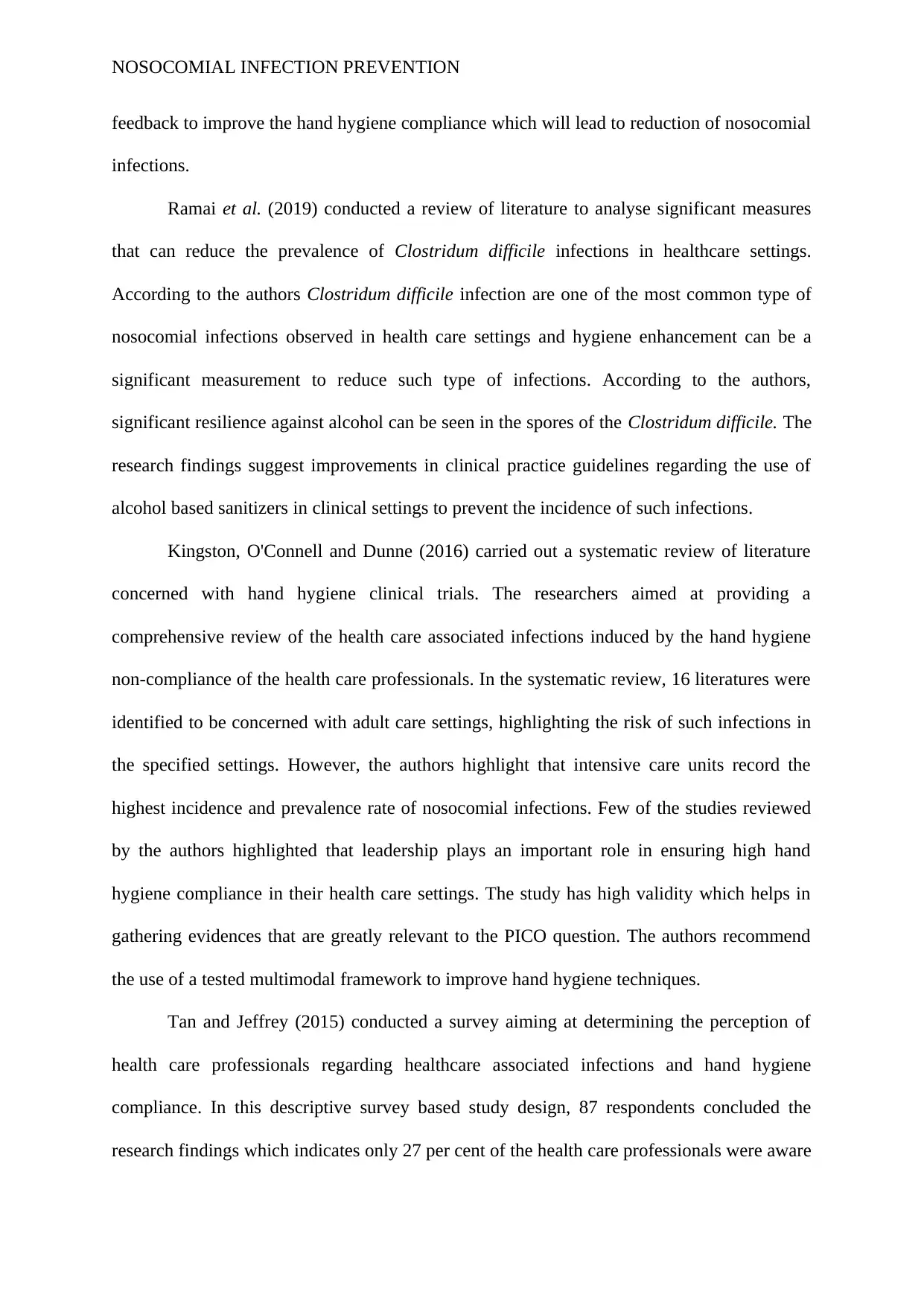
NOSOCOMIAL INFECTION PREVENTION
feedback to improve the hand hygiene compliance which will lead to reduction of nosocomial
infections.
Ramai et al. (2019) conducted a review of literature to analyse significant measures
that can reduce the prevalence of Clostridum difficile infections in healthcare settings.
According to the authors Clostridum difficile infection are one of the most common type of
nosocomial infections observed in health care settings and hygiene enhancement can be a
significant measurement to reduce such type of infections. According to the authors,
significant resilience against alcohol can be seen in the spores of the Clostridum difficile. The
research findings suggest improvements in clinical practice guidelines regarding the use of
alcohol based sanitizers in clinical settings to prevent the incidence of such infections.
Kingston, O'Connell and Dunne (2016) carried out a systematic review of literature
concerned with hand hygiene clinical trials. The researchers aimed at providing a
comprehensive review of the health care associated infections induced by the hand hygiene
non-compliance of the health care professionals. In the systematic review, 16 literatures were
identified to be concerned with adult care settings, highlighting the risk of such infections in
the specified settings. However, the authors highlight that intensive care units record the
highest incidence and prevalence rate of nosocomial infections. Few of the studies reviewed
by the authors highlighted that leadership plays an important role in ensuring high hand
hygiene compliance in their health care settings. The study has high validity which helps in
gathering evidences that are greatly relevant to the PICO question. The authors recommend
the use of a tested multimodal framework to improve hand hygiene techniques.
Tan and Jeffrey (2015) conducted a survey aiming at determining the perception of
health care professionals regarding healthcare associated infections and hand hygiene
compliance. In this descriptive survey based study design, 87 respondents concluded the
research findings which indicates only 27 per cent of the health care professionals were aware
feedback to improve the hand hygiene compliance which will lead to reduction of nosocomial
infections.
Ramai et al. (2019) conducted a review of literature to analyse significant measures
that can reduce the prevalence of Clostridum difficile infections in healthcare settings.
According to the authors Clostridum difficile infection are one of the most common type of
nosocomial infections observed in health care settings and hygiene enhancement can be a
significant measurement to reduce such type of infections. According to the authors,
significant resilience against alcohol can be seen in the spores of the Clostridum difficile. The
research findings suggest improvements in clinical practice guidelines regarding the use of
alcohol based sanitizers in clinical settings to prevent the incidence of such infections.
Kingston, O'Connell and Dunne (2016) carried out a systematic review of literature
concerned with hand hygiene clinical trials. The researchers aimed at providing a
comprehensive review of the health care associated infections induced by the hand hygiene
non-compliance of the health care professionals. In the systematic review, 16 literatures were
identified to be concerned with adult care settings, highlighting the risk of such infections in
the specified settings. However, the authors highlight that intensive care units record the
highest incidence and prevalence rate of nosocomial infections. Few of the studies reviewed
by the authors highlighted that leadership plays an important role in ensuring high hand
hygiene compliance in their health care settings. The study has high validity which helps in
gathering evidences that are greatly relevant to the PICO question. The authors recommend
the use of a tested multimodal framework to improve hand hygiene techniques.
Tan and Jeffrey (2015) conducted a survey aiming at determining the perception of
health care professionals regarding healthcare associated infections and hand hygiene
compliance. In this descriptive survey based study design, 87 respondents concluded the
research findings which indicates only 27 per cent of the health care professionals were aware
Paraphrase This Document
Need a fresh take? Get an instant paraphrase of this document with our AI Paraphraser
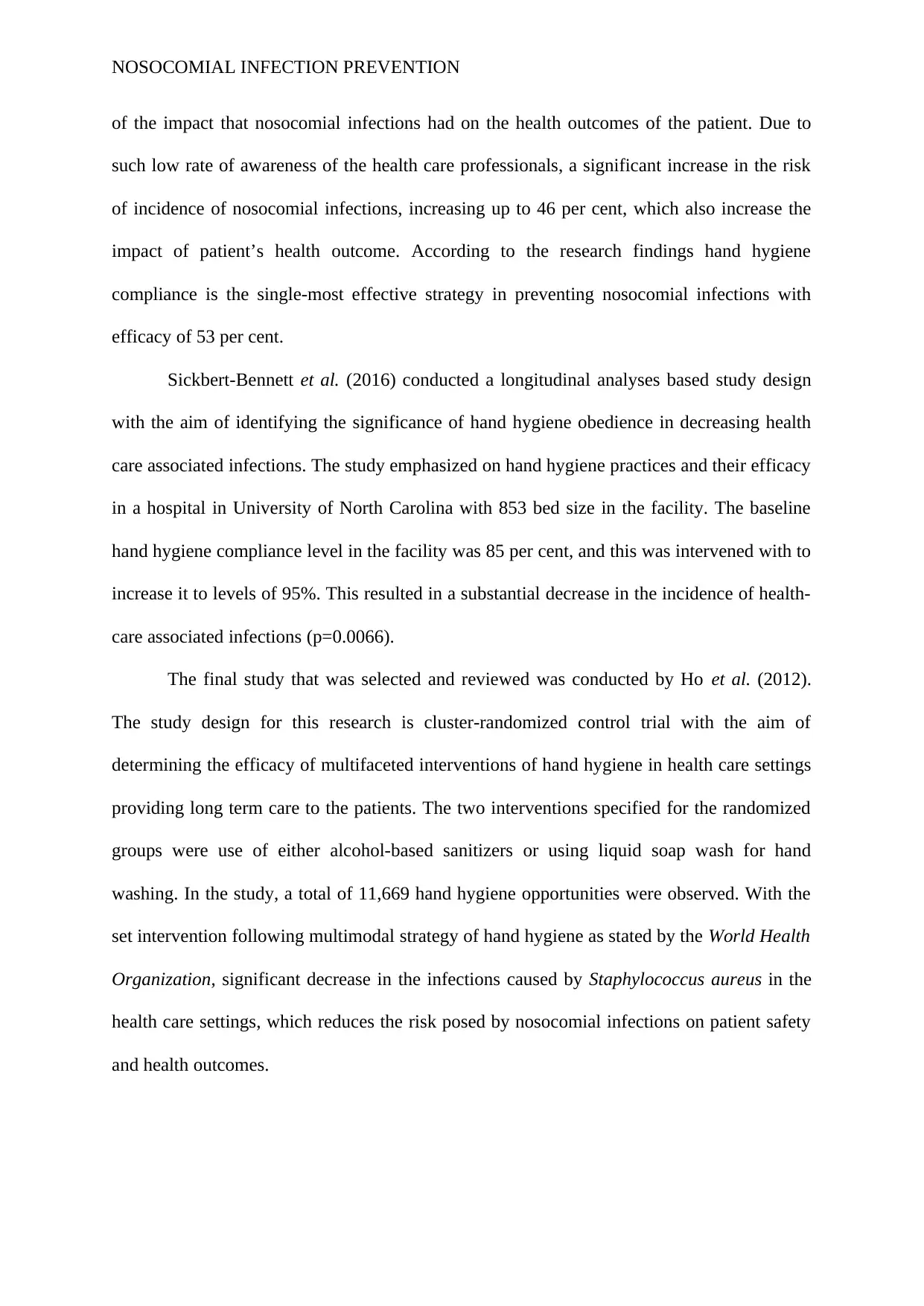
NOSOCOMIAL INFECTION PREVENTION
of the impact that nosocomial infections had on the health outcomes of the patient. Due to
such low rate of awareness of the health care professionals, a significant increase in the risk
of incidence of nosocomial infections, increasing up to 46 per cent, which also increase the
impact of patient’s health outcome. According to the research findings hand hygiene
compliance is the single-most effective strategy in preventing nosocomial infections with
efficacy of 53 per cent.
Sickbert-Bennett et al. (2016) conducted a longitudinal analyses based study design
with the aim of identifying the significance of hand hygiene obedience in decreasing health
care associated infections. The study emphasized on hand hygiene practices and their efficacy
in a hospital in University of North Carolina with 853 bed size in the facility. The baseline
hand hygiene compliance level in the facility was 85 per cent, and this was intervened with to
increase it to levels of 95%. This resulted in a substantial decrease in the incidence of health-
care associated infections (p=0.0066).
The final study that was selected and reviewed was conducted by Ho et al. (2012).
The study design for this research is cluster-randomized control trial with the aim of
determining the efficacy of multifaceted interventions of hand hygiene in health care settings
providing long term care to the patients. The two interventions specified for the randomized
groups were use of either alcohol-based sanitizers or using liquid soap wash for hand
washing. In the study, a total of 11,669 hand hygiene opportunities were observed. With the
set intervention following multimodal strategy of hand hygiene as stated by the World Health
Organization, significant decrease in the infections caused by Staphylococcus aureus in the
health care settings, which reduces the risk posed by nosocomial infections on patient safety
and health outcomes.
of the impact that nosocomial infections had on the health outcomes of the patient. Due to
such low rate of awareness of the health care professionals, a significant increase in the risk
of incidence of nosocomial infections, increasing up to 46 per cent, which also increase the
impact of patient’s health outcome. According to the research findings hand hygiene
compliance is the single-most effective strategy in preventing nosocomial infections with
efficacy of 53 per cent.
Sickbert-Bennett et al. (2016) conducted a longitudinal analyses based study design
with the aim of identifying the significance of hand hygiene obedience in decreasing health
care associated infections. The study emphasized on hand hygiene practices and their efficacy
in a hospital in University of North Carolina with 853 bed size in the facility. The baseline
hand hygiene compliance level in the facility was 85 per cent, and this was intervened with to
increase it to levels of 95%. This resulted in a substantial decrease in the incidence of health-
care associated infections (p=0.0066).
The final study that was selected and reviewed was conducted by Ho et al. (2012).
The study design for this research is cluster-randomized control trial with the aim of
determining the efficacy of multifaceted interventions of hand hygiene in health care settings
providing long term care to the patients. The two interventions specified for the randomized
groups were use of either alcohol-based sanitizers or using liquid soap wash for hand
washing. In the study, a total of 11,669 hand hygiene opportunities were observed. With the
set intervention following multimodal strategy of hand hygiene as stated by the World Health
Organization, significant decrease in the infections caused by Staphylococcus aureus in the
health care settings, which reduces the risk posed by nosocomial infections on patient safety
and health outcomes.
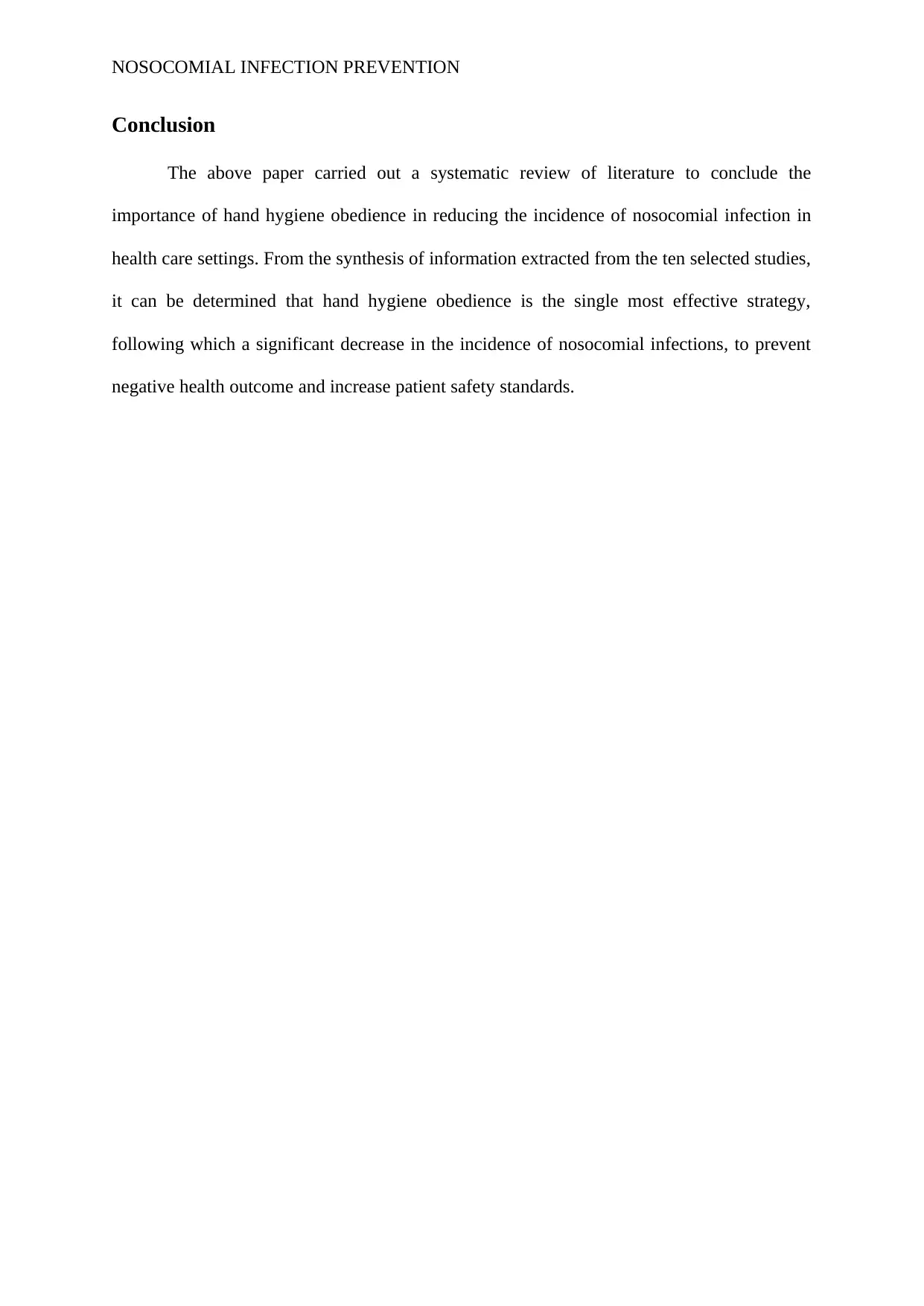
NOSOCOMIAL INFECTION PREVENTION
Conclusion
The above paper carried out a systematic review of literature to conclude the
importance of hand hygiene obedience in reducing the incidence of nosocomial infection in
health care settings. From the synthesis of information extracted from the ten selected studies,
it can be determined that hand hygiene obedience is the single most effective strategy,
following which a significant decrease in the incidence of nosocomial infections, to prevent
negative health outcome and increase patient safety standards.
Conclusion
The above paper carried out a systematic review of literature to conclude the
importance of hand hygiene obedience in reducing the incidence of nosocomial infection in
health care settings. From the synthesis of information extracted from the ten selected studies,
it can be determined that hand hygiene obedience is the single most effective strategy,
following which a significant decrease in the incidence of nosocomial infections, to prevent
negative health outcome and increase patient safety standards.
⊘ This is a preview!⊘
Do you want full access?
Subscribe today to unlock all pages.

Trusted by 1+ million students worldwide
1 out of 20
Related Documents
Your All-in-One AI-Powered Toolkit for Academic Success.
+13062052269
info@desklib.com
Available 24*7 on WhatsApp / Email
![[object Object]](/_next/static/media/star-bottom.7253800d.svg)
Unlock your academic potential
Copyright © 2020–2025 A2Z Services. All Rights Reserved. Developed and managed by ZUCOL.





